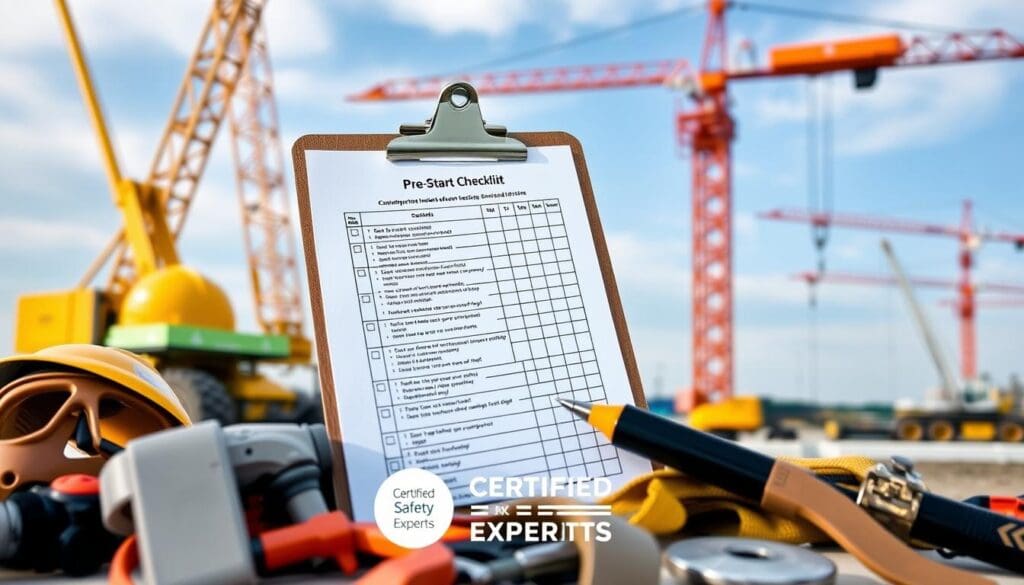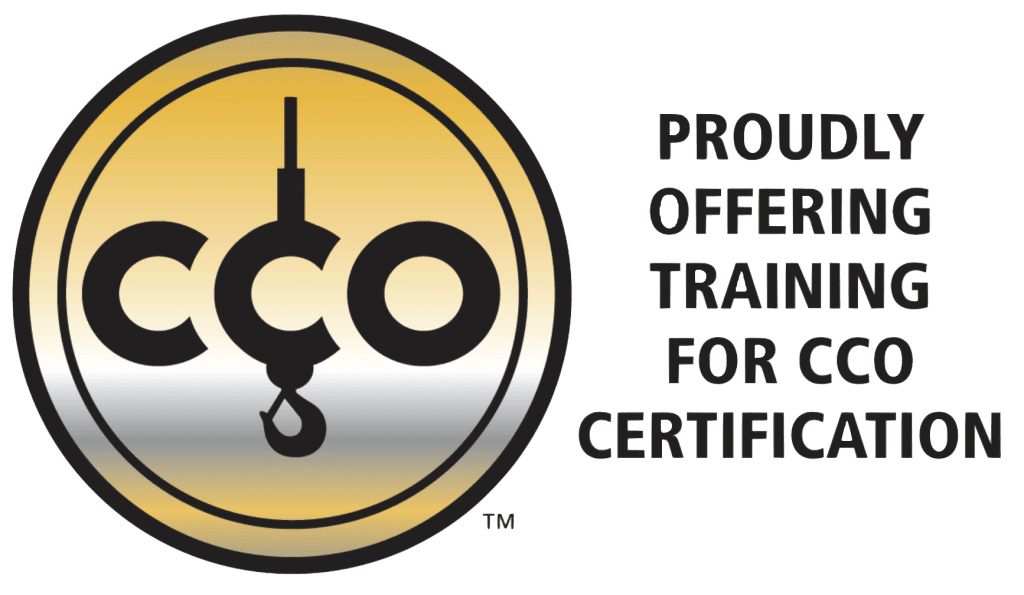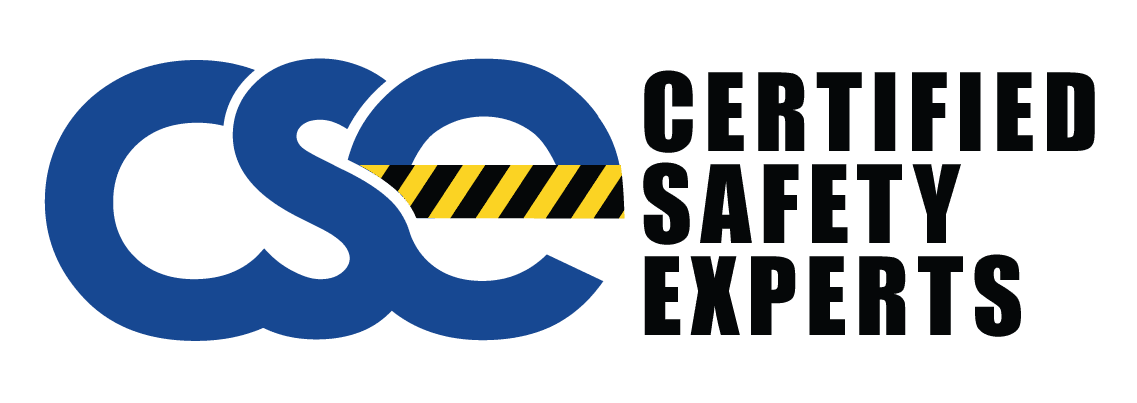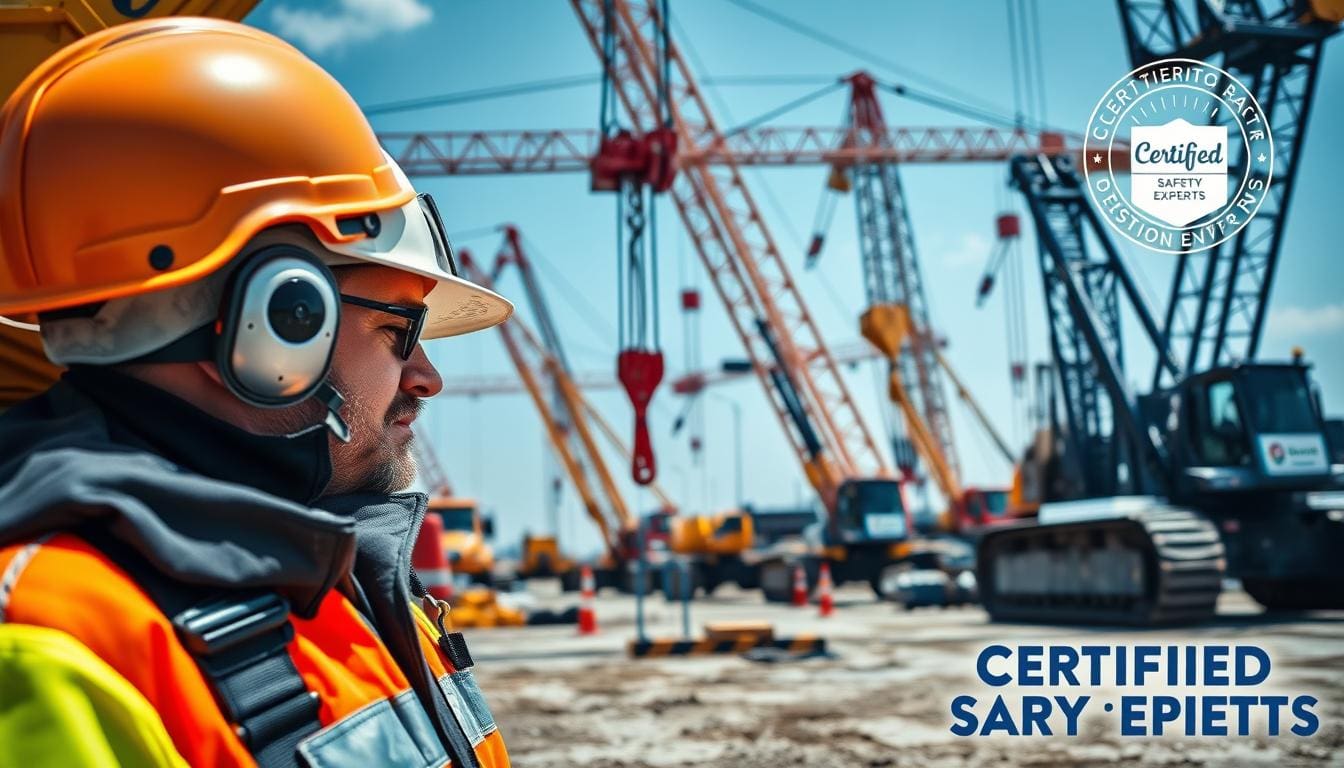Have you ever thought about the dangers in a crane not checked before use? Neglecting a pre-start crane inspection can cause big problems. It’s important for both operators and site managers to know how crucial a thorough crane safety check is. Doing a pre-operational crane check keeps operators safe and helps your equipment last longer, following OSHA rules and the maker’s advice.
Key Takeaways
- Pre-start crane inspections are key to avoiding accidents and equipment failure.
- Regular checks keep operators safe and make sure you follow OSHA rules.
- Following the maker’s upkeep advice makes your equipment last longer.
- Pre-operational crane checks are crucial in cutting down on workplace incidents.
- A detailed inspection list looks at mechanical, electrical, and structural parts.
Importance of Pre-Start Crane Inspections
Checking a crane before it starts is key in the construction and heavy machinery fields. These checks make sure crane operators are safe, help the equipment last longer, and follow the rules. Let’s look at why these points are important.
Protecting Operator Safety
Keeping crane operators safe is the top priority. Regular checks spot dangers before they lead to accidents. OSHA says many crane accidents can be stopped with careful inspections. A detailed maintenance checklist makes sure all safety steps are taken and risks are lowered.
Ensuring Equipment Longevity
Checking and maintaining cranes often can make them last longer. Following best practices means spotting and fixing problems early. This keeps the crane running well and cuts down on sudden breakdowns and expensive fixes.

Compliance with Inspection Standards
Following crane inspection rules is a must, not just a good idea. Groups like OSHA and ANSI set clear standards for safe crane use. A thorough inspection keeps businesses in line with these rules, avoiding fines and making the workplace safer.
Components of a Comprehensive Pre-Start Crane Inspection
A thorough pre-operation crane inspection is key for safety and efficiency. It helps meet crane inspection standards and boosts reliability. Let’s dive into the main parts of this process:
Mechanical Checks
Mechanical checks are crucial for a good pre-operation crane inspection. They cover the crane’s moving parts, brakes, and other key mechanical parts. It’s essential to check these to follow crane inspection standards.
- Inspect gears and sheaves for wear
- Check the functionality of the braking system
- Evaluate wire rope conditions
- Ensure lubrication levels are optimal
Electrical System Inspections
Electrical system inspections are vital to spot hazards that could cause failures. They should always be part of your pre-start crane checklist.
- Check all electrical connections for signs of wear or damage
- Inspect the condition of control panels
- Ensure the proper functioning of alarms and indicators
- Test emergency stop functions
Hydraulic System Reviews
Hydraulic systems are crucial for crane operations. Their maintenance is a must. A thorough hydraulic system review during your pre-operation crane inspection can avoid unexpected downtime.
- Inspect hydraulic hoses and fittings for leaks
- Check hydraulic fluid levels
- Test the functionality of hydraulic pumps and motors
- Ensure all hydraulic controls are responsive
Structural Integrity Verifications
Checking the structural integrity is key to spotting weaknesses that could affect the crane’s stability. This final step in the pre-start crane checklist ensures full compliance with crane inspection standards.
- Examine the crane’s frame and boom for cracks or deformities
- Inspect weld points and bolts
- Ensure outriggers are functional and properly set
- Verify that the crane is level before operation
Detailed Pre-Start Crane Inspection Checklist
The pre-start crane checklist is key to making sure cranes are safe and work right before they start. This guide helps operators do a full check before using the crane, following safety rules and standards.
-
Visual Inspection of the Crane Structure: Look for any damage, cracks, or changes in the crane’s parts, like the boom and jib.
-
Wire Ropes and Cables: Check wire ropes for wear, fraying, and if they’re well-lubricated. Make sure there are no kinks or bird caging issues.
-
Hydraulic System: Check the hydraulic system for leaks, enough fluid, and right hose connections.
-
Electrical Components: Look at all electrical parts, like cables and connectors. Make sure lights, alarms, and indicators work.
-
Safety Devices: Check that safety devices like limit switches, emergency stops, and overload indicators work well. These are key for a good crane check.
-
Control Systems: Test control systems for smooth and quick operation. Check load indicators and computer displays for correct readings.
-
Fluid Levels: Make sure all fluids like oil, coolant, and hydraulic fluid are at the right levels. This is part of the crane maintenance checklist.
-
Load Hook: Look at the load hook for wear, damage, or changes. Make sure the hook latch works and is secure.

Experts and maintenance teams have helped create this pre-start crane checklist. It aims to avoid accidents and make cranes last longer. By following this checklist, operators can make sure their equipment is safe and meets safety standards. Studies show that missing these checks can lead to big safety risks and problems with work. Sticking to the crane maintenance checklist keeps things running smoothly and safely.
Crane Safety Guidelines and Standards
Following crane safety guidelines and standards is key to safe crane use. The Occupational Safety and Health Administration (OSHA) has set up detailed crane safety rules. These rules aim to lower risks and improve safety on construction sites. They focus on checking equipment and training operators.
The American National Standards Institute (ANSI) also has strict standards for cranes. These standards stress the need for regular checks and upkeep to avoid mechanical failures and accidents. Following ANSI standards is vital for keeping operations safe and efficient.
The National Commission for the Certification of Crane Operators (NCCCO) provides important advice and certification programs. These programs make sure crane operators have the right skills and knowledge. Using these inspection rules helps make the workplace safer and cuts down on crane incidents.
By following these inspection rules and safety guidelines, companies can boost safety and efficiency. This makes the workplace safer for everyone.
Conclusion
Following a strict pre-start crane inspection is key for your equipment’s safety and performance. It involves checking mechanical parts, electrical systems, hydraulics, and the crane’s structure. This approach not only keeps operators safe but also makes your cranes last longer.
These practices are vital for following crane inspection standards and keeping your operations efficient. We’ve looked at how pre-start checks protect operators, extend crane life, and follow safety rules. Such inspections help avoid accidents and meet crane safety guidelines, giving everyone peace of mind.
To keep your workplace safe and compliant, call (919) 326-3742 for a professional crane inspection. Our experts will make sure your cranes meet all safety standards. Don’t risk safety – get your cranes checked and ready for use.




